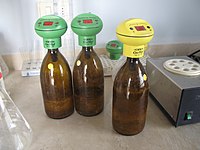
Photo from wikipedia
Coagulation-flocculation is an important process in removing suspended and colloidal matter from water in treatment plants. In this batch study, response surface methodology (RSM) was used to investigate the interactive… Click to show full abstract
Coagulation-flocculation is an important process in removing suspended and colloidal matter from water in treatment plants. In this batch study, response surface methodology (RSM) was used to investigate the interactive influences between selected operating parameters of coagulant and coagulant aid dosage as well as pH for an optimized condition of turbidity removal from Ilam wastewater treatment plant based on data from jar tests. In this study, two common coagulants including aluminum sulfate and ferric chloride were used. LT25 and LT27 were applied as coagulant aids. Aluminum sulfate yielded highest turbidity removal at a dosage of 5 mg L-1 at pH 7. For ferric chloride, the maximum efficiency was observed at dosage 5 mg L-1 at pH 9. Application of aluminum sulfate in the presence of LT27 showed the highest turbidity removal among the studied reagents, and the efficiency increased with the increase in dosage. Based on the results of the present study, aluminum sulfate generally yielded a higher turbidity removal. But, ferric chloride formed larger flocs. Moreover, LT27 had a higher efficiency compared with LT25. Finally, the RSM was indicated as an appropriate tool for the optimization of the coagulation-flocculation process by confirmation experiments.
Journal Title: DESALINATION AND WATER TREATMENT
Year Published: 2019
Link to full text (if available)
Share on Social Media: Sign Up to like & get
recommendations!